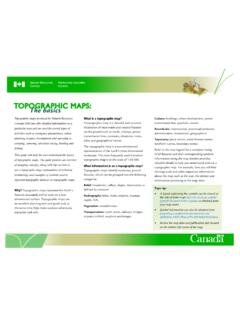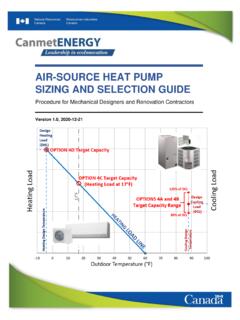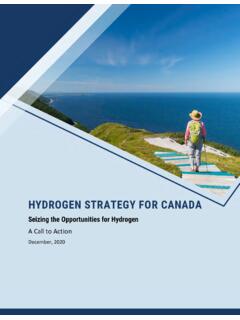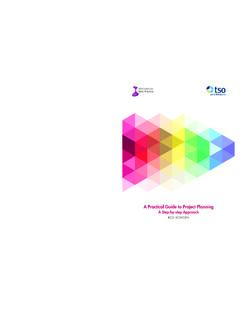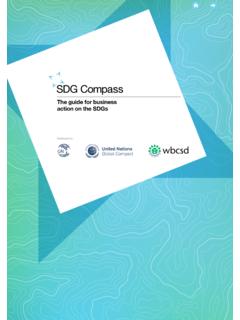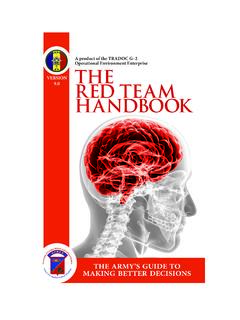Transcription of Stakeholder Engagement Guide with Worksheets
1 Stakeholder Engagement Guide with Worksheets Cat. No. M154-80/2014E-PDF ISBN or ISSN 978-1-100-24705-2 Her Majesty the Queen in Right of Canada, as represented by the Minister of Natural Resources, 2014 Acknowledgement: This Engagement Guide was extracted from the report, Stakeholder Communications and Engagement Guide for District Energy Systems, developed by Sustainable Cities International for Natural Resources Canada s CanmetENERGY Communities group, 2014. Neither Natural Resources Canada nor any of its employees makes any warranty, express or implied, or assumes any legal liability or responsibility for the accuracy, completeness or usefulness of its contents.
2 Reference in the report to any specific commercial product, process, service or organization does not necessarily constitute or imply endorsement, recommendation or favouring by Natural Resources Canada. The views and opinions of authors expressed in this report do not necessarily state or reflect those of Natural Resources Canada. Funding for this work was provided by Natural Resources Canada through the Program of Energy Research and Development. Ressources naturelles Canada et aucun de ses employ s ne font aucune garantie, formelle ou tacite, et n assument aucune responsabilit l gale ou autre l gard de l exactitude, de l exhaustivit ou de l utilit du contenu du rapport.
3 Toute r f rence dans le rapport quelque produit, processus, service ou organisation que ce soit ne constitue pas n cessairement une approbation, une recommandation ou une pr f rence de la part de Ressources naturelles Canada. Les points de vue et les opinions exprim s par les auteurs dans ce rapport ne sont pas et ne refl tent pas n cessairement ceux de Ressources naturelles Canada. Ces travaux ont t r alis s gr ce au financement fourni par Ressources naturelles Canada dans le cadre du Programme de recherche et de d veloppement nerg tiques. TABLE OF CONTENTS INTRODUCTION .. 5 A: RATIONALE FOR CREATING AN EXTERNAL PUBLIC Engagement STRATEGY .. 5 B: STEPS IN PLANNING AN EXTERNAL Engagement STRATEGY.
4 6 STEP 1: Understand the Local Context .. 7 STEP 2: Identify Stakeholders and Conduct Stakeholder Analysis .. 8 2a) Stakeholder 8 2b) Stakeholder Analysis .. 10 Guiding Questions for Stakeholder Identification & Analysis: .. 12 Example: Stakeholder identification and consultation for neighbourhood energy utility in Vancouver .. 13 STEP 3: Determine Key Messages .. 14 ) Use Mental Models and Framing to Enhance Message Delivery ..14 ) Create Messages to Address Specific Needs and Concerns ..16 STEP 4: Select Appropriate Public and Stakeholder Engagement Channels .. 18 Developers .. 19 Mass versus targeted communication: ..20 Mass Communication/ Engagement Approaches: ..20 Targeted Communication/ Engagement Approaches.
5 23 Example: The Value of Using Multiple Engagement Tools ..26 STEP 5: Create an Integrated Implementation Plan .. 27 C: POTENTIAL FUTURE ACTIONS DESIGN A MUNICIPAL Engagement STRATEGY .. 28 Phase 1: ..28 Phase 2: ..28 D: APPENDIX & Worksheets .. 29 WORKSHEET 1: THE PROJECT SCOPE AND CONTEXT ..30 WORKSHEET 2: Stakeholder IDENTIFICATION AND ANALYSIS - WORKSHEET 3: Stakeholder IDENTIFICATION AND ANALYSIS - CLASSIFICATION ..32 WORKSHEET 4: Stakeholder IDENTIFICATION AND ANALYSIS - PRIORITIZATION ..33 WORKSHEET 5: Stakeholder IDENTIFICATION AND ANALYSIS - STRATEGIZING ..34 WORKSHEET 6: COMMUNICATION MESSAGES AND PLATFORMS ..35 WORKSHEET 7: IMPLEMENTATION PLAN ..36 Examples: District Energy communication developed by Municipalities.
6 37 BONNYBROOK CENTER: OPEN HOUSE POSTER WHITEHORSE: DISTRICT ENERGY SYSTEMS POSTERS ..38 WHITEHORSE: DISTRICT ENERGY SYSTEMS POSTCARDS ..38 E: REFERENCES .. 39 DISTRICT ENERGY Stakeholder Engagement Guide For more information, contact CanmetENERGY: 5 INTRODUCTION This Guide is intended to assist Municipalities in developing their local Stakeholder Engagement strategies when considering District Energy. A District Energy System (DES) may also be referred to as a Thermal Grid (providing either heating and/ or cooling), and may also be a provider of locally generated electricity supplies (called co-generation), use local sources of renewable fuels to power the system, and have local renewable energy storage capacity.
7 A District Energy System is an incremental step towards a long term goal and as such the Engagement strategy should be considered not as a single event but rather as an ongoing activity. There are many examples of local district energy solutions, nationally and internationally, some of which can be found in the resources section of this Guide . However, the focus of this Guide is not on the technical aspects of District Energy development. Rather, it is a tool to help steer the Engagement process between a municipality and their local external stakeholders. For more information on District Energy technical issues and resources for Municipalities, such as the DE Learning Module for Municipal Planners, contact This Guide , with Worksheets and samples of some existing Stakeholder communication products from municipalities, is based on the fundamental principles for community Engagement , and has been developed as a starting point for Municipalities to utilize, or adapt, when they decide to proceed with development of a District Energy strategy.
8 A: RATIONALE FOR CREATING AN EXTERNAL PUBLIC Engagement STRATEGY Misconceptions exist around district energy systems. Potential end users, stakeholders, and municipal staff and elected officials may not be fully aware of how district energy systems work, their benefits, and contribution to enhancing the sustainability of communities (Canadian Urban Institute, CUI, 2011). This lack of awareness and misunderstanding is a barrier to district energy growth. It diminishes political leadership and the development of effective policies or incentives to foster greater deployment. In turn, economic challenges prevail. The failure of the industry to deliver a persuasive and well-defined message about district energy often lessens the interest in tackling the knowledge challenge (CUI, 2011).
9 DISTRICT ENERGY Stakeholder Engagement Guide For more information, contact CanmetENERGY: 6 Greater and effective communication, successful Stakeholder Engagement and strong brand positioning are thus vital in addressing misconceptions, growing knowledge around this technology, and leveraging its integration into energy planning in communities. Besides tackling the preceding challenges, effective public and Stakeholder Engagement offers a number of broader benefits (Vanderheiden, 2008; Gonzalez & Tyler, 2007; Scholsberg, 1999 in Paavola, 2008; Thibault & Walker, 1975 in Lind & Tyler, 1988; Few et al., 2006 in Bjornberg & Hansson, 2011). It allows people to present their views and have some control over policies that affect them.
10 It enables governments to learn valuable information from local knowledge in order to make more informed and sustainable decisions. It helps to increase the legitimacy of policies. It makes initiatives easier to implement and more readily accepted. It enhances trust between stakeholders and government. If a just and inclusive process is used, there is a greater chance of achieving desirable and fair outcomes. Due to the complexity of district energy systems and the diversity of the stakeholders, it is important for an Engagement strategy to follow a structured and informed process. This process is discussed in the remainder of this Guide . B: STEPS IN PLANNING AN EXTERNAL Engagement STRATEGY Five major steps are recommended when developing an Engagement strategy for district energy.

